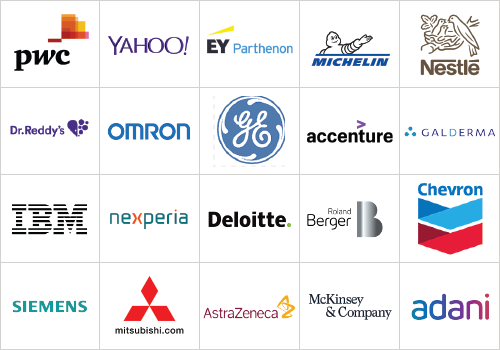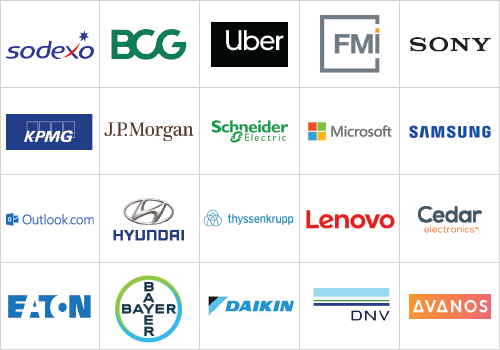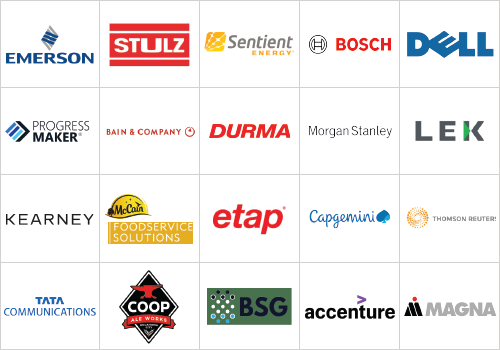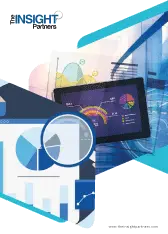About Us
The Insight Partners is a global research and consulting company that teams up with industry players to address their most pressing business difficulties and explore growth opportunities. We are a one-stop shop for providing qualitative and quantitative insight gleaned through industry research.
Through our market intelligence services our clients can better identify its market segment, market penetration, and overall opportunity with the aid of multi-level information in the analyses. Inclusion of competitor intelligence, focusing on details about a company's description, competitors, products and services, latest developments , and financial information can help strategy and marketing leaders choose the right decision based on the underlying information.
Our team of subject matter experts and consultants are dedicated to offering our clients the best possible research and analysis at an affordable cost. Our success depends on a culture of close cooperation and a large, diversified global community that is committed to improving the world and one another every day. Our success depends on a culture of close cooperation and commitment to improving decision making for business growth and prosperity.



Why Choose Us
Experience & Expertise
With a deep understanding of the market, we turn information into actionable insights by bringing in expert opinion to support your decisions.
Customer Focused Services
Understanding the customer's research needs, preferences, and expectations and delivering the desired analyses.
Passion & Commitment
We are commitment to the highest level of professional and ethical standards, which are at the core of our values and beliefs.
Diversified Solutions
We develop and provide a range of solutions to support your assessment of the market and decision analytics.
Checkout Our Products
Technetium-99m Market
Dec 2025
Size and Forecast (2021 - 2031), Global and Regional Share, Trend, and Growth Opportunity Analysis Report Coverage: By Application (Cardiovascular, Bone Scan, Respiratory, Tumor Imaging, and Others), End User (Hospitals, Diagnostic and Imaging Centers, and Others) and Geography (North America, Europe, Asia Pacific, Middle East and Africa, and South and Central America)
Size and Forecast (2021 - 2031), Global and Regional Share, Trend, and Growth Opportunity Analysis Report Coverage: By Flow Rate (Low, Medium, and High), Application (Semiconductors, Food and Beverages Industry, Chemicals, Pharmaceutical and Healthcare Industry, Oil and Gas, and Others), and Geography (North America, Europe, Asia Pacific, Middle East and Africa, and South and Central America)
Sternal Closure Systems Market
Dec 2025
Size and Forecast (2021 - 2031), Global and Regional Share, Trend, and Growth Opportunity Analysis Report Coverage: By Product (Closure Devices (Wire, Plates & Screw, Cables, and Clips) and Bone Cement), Procedure (Median Sternotomy, Hemisternotomy, Bilateral Thoracosternotomy, and Others), Material (Titanium, Polyether Ether Ketone, Stainless Steel, and Others), and Geography (North America, Europe, Asia Pacific, Middle East and Africa, and South and Central America)
Size and Forecast (2021 - 2031), Global and Regional Share, Trend, and Growth Opportunity Analysis Report Coverage: By Flash Memory Type (NAND Flash Memory and NOR Flash Memory), NAND Flash Memory (SLC, MLC, TLC, and Others), NOR Flash Memory (Parallel NOR and Serial NOR), NAND Flash Memory Architecture (2D NAND and 3D NAND), NOR Flash Memory Density (Upto 2 MB, 4 MB to 64 MB, 128 MB to 512 MB, and Greater than 1 GB), NAND Flash Memory Density (Upto 2 GB, 4 GB to 64 GB, 128 GB to 512 GB, and Above 1 Tb), and Region (North America, Europe, Asia Pacific, Middle East and Africa, and South and Central America)
Size and Forecast (2021 - 2031), Global and Regional Share, Trend, and Growth Opportunity Analysis Report Coverage: By Flow Rate (Low, Medium, and High), Application (Semiconductors, Food and Beverages Industry, Chemicals, Pharmaceutical and Healthcare Industry, Oil and Gas, and Others), and Geography (North America, Europe, Asia Pacific, Middle East and Africa, and South and Central America)
Size and Forecast (2021 - 2031), Global and Regional Share, Trend, and Growth Opportunity Analysis Report Coverage: By Mounting Type (Wall Mounted and Ceiling Mounted), Capacity [Between Ten and Thirty Cubic Meters (10–30 cu m), Less than Ten Cubic Meters (less than 10 cu m), and Greater than Thirty Cubic Meters (Greater than 30 cu m)], End-User Industry (Food Retail, HoReCa, Cold Chain Logistics, Pharmaceutical or Healthcare, and Others), and Geography (North America, Europe, Asia Pacific, Middle East & Africa, and South & Central America)
Data Center Equipment Market
Apr 2025
Size and Forecast (2021 - 2031), Global and Regional Share, Trend, and Growth Opportunity Analysis Report Coverage: By Equipment Type [Servers, Storage Devices, Cooling Equipment, Power Distribution Units (PDUs), Racks, Enclosures, and Others], Tier Type (Tier 3, Tier 4, Tier 1, and Tier 2), and Geography
Veterinary Vaccines Market
Apr 2025
Size and Forecast (2021 - 2031), Global and Regional Share, Trend, and Growth Opportunity Analysis Report Coverage: By Technology (Live Attenuated Vaccines, Inactivated Vaccines, Recombinant Vaccines, Toxoid Vaccines, and Others), Animal Type (Companion {Dogs, Cat, Horses, and Others}, Livestock and Poultry {Chicken, Cattle, and Others}), Route of Administration (Intramuscular, Subcutaneous, and Others), End User (Veterinary Hospitals, Veterinary Clinics, and Others), and Geography
Size and Forecast (2021 - 2031), Global and Regional Share, Trend, and Growth Opportunity Analysis Report Coverage: By Component [Software and Services (Professional Services and Managed Services)], Deployment (Public Cloud, Hybrid Cloud and Private Cloud), Enterprise Size (Large Enterprises and SMEs), Sales Channel (Direct Sales and Channel Partners), End User [Discrete Industry (Automotive, Electronics, Semiconductors, Aerospace and Defense, Medical Devices, Consumer Packaged Goods and Others) and Process Industry(Food and Beverages, Pharmaceuticals and Life Sciences, Chemicals, Oil and Gas, Pulp and Paper, Energy and Power, Water and Waste Water Treatment and Others)], and Geography
RTD Alcoholic Beverages Market
Apr 2025
Size and Forecast (2021 - 2031), Global and Regional Share, Trend, and Growth Opportunity Analysis Report Coverage: By Product Type [Hard Seltzers (Citrus Fruits, Berries, Tropical Fruits, and Other Hard Seltzers), RTD Cocktails, Wine-Based Spritzers, and Others], Base Type [Malt-Based, Wine-Based, and Spirit-Based], Packaging Type [Bottles, Cans, and Others], Category [Low or No Sugar and Regular], Distribution Channel [On-Trade and Off-Trade (Supermarkets and Hypermarkets, Specialty Stores, Online Retail, and Others)], and Geography
Size and Forecast (2021 - 2031), Global and Regional Share, Trend, and Growth Opportunity Analysis Report Coverage: By Type (Lithium Ion and Others), Connection Type (On-Grid and Off-Grid), End User (Commercial, Utilities, and Residential), and Geography
Lubricants Market
Mar 2025
Size and Forecast (2021 - 2031), Global and Regional Share, Trend, and Growth Opportunity Analysis Report Coverage: By Base Oil (Mineral Oil, Synthetic Oil, and Bio-based Oil), Type (Hydraulic Fluid, Engine Oil, Driveline Lubricants, Metalworking Fluids, Grease, Process Oils, Coolants, and Others), End-Use Industry [Automotive (Passenger Cars, Light Commercial Vehicles, Heavy Commercial Vehicles, and Others), Building and Construction, Power Generation, Mining and Metallurgy, Food Processing, Oil and Gas, Marine, Aviation, and Others], and Geography
Value Chain Analysis
Value chain analysis is a powerful tool to determine a problem in the supply chain ecosystem or judge the effectiveness of the processes in a structured way. We provide a deep dive analysis on value chain covering a plethora of support and primary activities such as technology development, component manufacturing, research & development activities, infrastructure, operations, inbound logistics, marketing & sales, and others.
Vendor Ecosystem Analysis
Understand the synergies within the network of vendors to identify and further strengthen relationships complementing your business growth. Benchmark your competitors sourcing strategy to improve creativity and innovation to lower the cost of production or expand your vendor list.
Company Benchmarking
We help you create a yardstick to evaluate your competitor providing better understanding of your competitive landscape. Identify your strengths and weaknesses, set performance goals with better understanding for your competition.
Go-To-Market Strategy
Our consultants provide a perfect mix of go-to-market strategy ranging from marketing mix, customer analysis, market selection, and a host of other market strategies. A pinpointed, well executed market strategy can create growth multipliers through a successful implementation.
Identifying market potential and opportunities
The Total Addressable Market (TAM) is an essential assessment and analysis to identify the untapped revenue pockets. Our consultants can help you unearth possible expansion opportunities such through – demand analysis, consumer voice, geographic expansion, product line expansion, and building competitive advantages for faster scalability.
Climate Change and ESG
Climate change is the greatest challenge of our generation – and corporates around the world are stepping up towards implementing ambitious net zero commitments. We help clients identify and measure climate innovation, sustainability solutions and track energy transitions that the businesses are embracing to achieve business sustainability strategy.
Intelligence Cloud - eInsights
The key findings highlight crucial progressive industry trends in the global market, thereby allowing players across the value chain to develop effective long-term strategies. This can give a clear picture of the competitors to your organization and enable in decision-making process by understanding the strategies and accordingly devise business expansion plans.

Fast and Secure
You Can Quickly and Securely Access Market Research Data via This Platform and It Helps You Get the Required Data Points in Preferred Format Instantly
Monthly Updates
Access to Latest Industry and Company News Updates—New Product Launches, Mergers Acquisitions, Collaborations, etc.
Cloud
This Platform is Based on a Secured Cloud Platform Providing Ease of Use from Anywhere and Anytime

Subscription
This Platform Serves as an Ideal Solution for All Your Research Requirements. The Industry and Company Research Reports Let You Understand the Market Dynamics Across Various Subsegments and Geographies
Analyst Support
24*7 Analyst Support Helps Resolve Your Query and Obtain Clear Understanding on Market Research Information
Display Features
Display Features Our Platform Offers Innovative Display Features to Present Market Data and Allow Users Understand and Download the Data in Various Formats
Fast and Secure
You Can Quickly and Securely Access Market Research Data via This Platform and It Helps You Get the Required Data Points in Preferred Format Instantly
Monthly Updates
Access to Latest Industry and Company News Updates—New Product Launches, Mergers Acquisitions, Collaborations, etc.
Cloud
This Platform is Based on a Secured Cloud Platform Providing Ease of Use from Anywhere and Anytime
Subscription
This Platform Serves as an Ideal Solution for All Your Research Requirements. The Industry and Company Research Reports Let You Understand the Market Dynamics Across Various Subsegments and Geographies
Analyst Support
24*7 Analyst Support Helps Resolve Your Query and Obtain Clear Understanding on Market Research Information
Display Features
Display Features Our Platform Offers Innovative Display Features to Present Market Data and Allow Users Understand and Download the Data in Various Formats
Industries

Expert Insights into a High-Tech, Evolving Sector
Aerospace & defense is a technology-focused industry. Several trailblazing government and private companies across the globe are investing huge sums to design robust systems and equipment that are technologically enhanced, miniaturized, and lightweight to enhance the operationality of the modern-day aircraft models. Additionally, the noteworthy growth in passenger and cargo air traffic has propelled the demand for aircraft models across geographies. The passenger traffic growth trend is anticipated to catapult over 5% annually over the next decade. Similarly, the air cargo volume is also expected to soar substantially over the next decade.
Driving Demand Through Innovation and Air Traffic Growth
Asymmetric warfare generates significant demand for robust technologies for dismounted soldiers, ground vehicles, airborne vehicles, and naval vehicles. Continuous investments toward defense or military technologies are also boosting the production and procurement of advanced weaponries and ammunitions. Countries such as the US, China, India, Japan, France, and the UK capitalize heavily on defense technologies, which bolster the defense industry size year-on-year.
The Future of Defense: Smart Systems and Strategic Investment
The future of defense technologies is foreseen to be prominent owing to the evolution and procurement of technologies such as precision munitions, cybersecurity, C5ISR, and unmanned vehicles. Companies operating in the defense industry emphasize heavily on marketplace, understand the demand among the defense forces worldwide, and offer value for money on products and systems.

Technology-Driven Shifts in Mobility and Design
The automotive industry has revolutionized transportation with technological advancements. Moreover, the automotive industry has been a stimulant in economic growth. It serves as a vital source of employment. Despite its achievements, the automotive industry faces challenges surrounding environmental concerns, prompting a shift toward electric vehicles and alternative fuels. The push for greener transportation options has become a priority to minimize the industry's carbon footprint. Constant advancements in technology continue to propel the industry and revolutionize the way vehicles are designed and manufactured.
Electric and Autonomous Vehicles Reshaping the Future
Electric and autonomous vehicles have gained immense popularity in recent times due to their lower contribution to overall greenhouse gas (GHG) emissions. With the rising penetration of electric vehicles in the transportation sector, GHG emissions are expected to decline in the coming years. These vehicles are also insulated from fuel price fluctuations, making them a more stable choice over conventional vehicles. Increasing investments, consumer interest, and research efforts continue to drive this pivotal trend in the industry.
Logistics, Infrastructure, and the Economic Impact of Transport
The transportation industry plays a vital role in the movement of people, products, and services. Its performance is crucial for sustaining economies, promoting commerce, and strengthening societal connectivity. Efficient logistics and cost-effective operations are key to lowering expenses, improving customer satisfaction, and maintaining a competitive edge. Seamless coordination among producers, suppliers, logistics providers, and retailers ensures continuous market supply. The automotive and transportation domain offers rich market data to support strategic decision-making.

Global Financial Infrastructure and Economic Impact
The Banking, Financial Services, and Insurance (BFSI) sector plays a pivotal role in the global economy, serving as the backbone of financial infrastructure and facilitating economic transactions worldwide. Comprising banks, insurance companies, investment firms, and various financial institutions, the BFSI sector forms a complex ecosystem that influences economic growth, stability, and innovation on a global scale.
Adapting to a Rapidly Evolving Financial Landscape
The BFSI sector operates within a dynamic landscape shaped by technological advancements, regulatory frameworks, market trends, and consumer behaviors. Key factors driving the evolution of this sector include digitalization, globalization, regulatory reforms, demographic shifts, and the emergence of fintech disruptors.
Technology and Innovation at the Core of BFSI Transformation
Globally, the BFSI sector is characterized by intense competition, evolving customer preferences, and the need to adapt to rapid technological and market changes. Financial institutions are increasingly leveraging technologies such as artificial intelligence, blockchain, and data analytics to enhance operational efficiency, improve risk management, and elevate the customer experience.
Navigating Globalization, Compliance, and Cybersecurity Risks
Globalization has expanded cross-border transactions and interconnected financial systems, while simultaneously introducing challenges related to regulatory compliance, cybersecurity threats, and geopolitical instability. Institutions must address these risks while seizing the opportunities offered by broader market access.
ESG Integration and the Rise of Responsible Finance
Sustainability and ethical finance have become critical areas of focus. Financial institutions are now aligning their strategies with Environmental, Social, and Governance (ESG) principles, aiming to improve transparency, accountability, and long-term resilience in the face of shifting societal expectations and regulatory pressures.

Chemicals & materials is a diverse and crucial industry that plays an essential role in producing a wide range of products and materials utilized in multiple industries and daily life. It encompasses the research, development, production, and distribution of chemicals, polymers, plastics, metals, ceramics, and other materials. This industry serves as a foundation for many sectors, including manufacturing, construction, electronics, healthcare, agriculture, and more.
The chemicals & materials industry is witnessing a transformative phase, initiated by dynamic trends that are shaping its future course of growth and development. Sustainability has emerged as the central theme, speeding this shift toward greener and more sustainable practices along with the adoption of circular economy principles.
Bio-based and renewable materials are gaining importance as alternatives to traditional petrochemical-derivates, positioning themselves to expand with the global push for reduced carbon emissions.
The industry was plagued by the recent disruptions; however, it emerged stronger with a more resilient and optimized supply chain by embracing innovation and sustainability to overcome the global challenges.
Technological advancements, including nanotechnology and digitalization, are driving the development of advanced materials, while smart coatings and functional materials are improving performance across sectors. With changing market dynamics and consumer preferences, the chemicals & materials industry is well positioned to play a pivotal role in driving sustainability, innovation, and meeting new challenges.

Market Research from Leading Experts
The Consumer goods industry produces and promotes a wide range of items, including personal care products, clothing, furniture, household items and small appliances. This industry is shaped by ever-evolving consumer preferences, technological advancements, and socioeconomic trends. The impact of digital transformation and innovation has empowered customers, giving them control over the decision-making process by instantly comparing and evaluating products and e-commerce services in a real-time environment.
Transform Insights into Advantage with Expert Guidance
The consumer goods industry's value chain comprises of interconnected components, including efficient inbound processes, strategic sourcing and procurement, product development and manufacturing, marketing and sales efforts, human resources management, aftersales services, efficient supply networks, and the integration of digitization. Successful synergies with technology implementation such as Internet of Things (IoT) and customer relationship management (CRM) applications is enabling manufacturers to better understand their target market, create a close relationship with consumers, and uplift business volumes and market presence.
Market Expansion Powered by Innovation and Global Trends
The consumer goods sector is closely related to many other sectors, including manufacturing, advertising, and retail. It accounts for almost the two-thirds of the global trade volume and helps create new job opportunities. Therefore, this sector plays an important role in the global economy buildup. Rise in disposable incomes, increasing consumer spending, and improving lifestyles with changing preferences are the key factors encouraging the manufacturers to introduce new and innovative products in the market. Globalization and logistics advancements have further boosted the consumer goods market growth. Constant innovations and improvisations in consumer products provide new target markets and product expansion opportunities to the market players.
The Electronics & Semiconductor (E&S) industry continues to innovate and drive technological progress, with ongoing advancements in areas such as miniaturization, energy efficiency, connectivity, and artificial intelligence. Its influence extends across industries, shaping the way we live, work, communicate, and interact with the world around us.
The E&S industry plays a pivotal role in modern technology and has a deep impact on various aspects of daily life, from communication and entertainment to healthcare and transportation. However, the global macroeconomic and geopolitical factors are the dominant forces shaping the E&S industry. Rising interest rates, high inflation, brittle consumer confidence, and supply chain bottlenecks have curtailed the industry growth.
The factors driving the semiconductor market growth are connected devices, digital transformation, consumer electronics, increased automotive demand, industrial applications, etc. While keeping pace with evolving innovative designs and products, the E&S industry faces challenges such as supply disruptions, pricing pressures, environment sustainability, and economic viability.
Advancements in emerging technologies such as autonomous driving, artificial intelligence (AI), 5G, and the Internet of Things (IoT), as well as consistent R&D spending and competition among the major players, the global E&S industry is expected to continue its robust growth.

The energy and power industry is at the forefront of addressing multiple global challenges such as climate change, energy security, and sustainable development. Technological developments, changing regulations, and shifting customer behavior all contribute to the industry's progress, making it more dynamic and an important sector for the future.
The previously well-established demand trends are changing as a result of the present energy crisis. Industries are currently susceptible to volatile worldwide pricing as well as genuine concerns about rationing and output limit reduction. Consumers are adjusting their energy use in response to high prices and, in some cases, emergency demand reduction campaigns or blackouts. The energy sector today is battling with significant short- and long-term uncertainties. The near-term outlook for demand is clouded by recessionary fears, while demand push from China may increase oil consumption as it exits lockdowns and return to normal. The sufficiency of supply is called into question with sanctions against Russia and declining production capacity by oil and gas producers.
The power industry encompasses a wide range of activities related to power generation, distribution, and consumption to meet various needs, from residential and commercial electricity to industrial processes and transportation. With rising emphasis on energy sustainability, meeting present energy needs without compromising climate concerns is of the essence. The fastest-growing power generation sources are renewables, particularly solar PV and wind, which are likely to generate 43% of the world's electricity in 2030 compared to 28% currently.

Food & beverages industry includes all businesses engaged in transforming unprocessed agricultural materials into consumer food items. The overall industry supply chain involves food processing, packaging, and distribution. It excludes the production of raw foods, which belongs to the closely connected agriculture sector. Food & beverages is a lucrative industry worldwide owing to rising global population, increasing per capita disposable income, and growing organized retail industry. The penetration of e-commerce in the food & beverages industry further propels its growth. The rising trend of veganism and escalating consumption of organic, gluten-free, and kosher food products are among the other factors contributing to the food & beverages industry expansion. At ingredient or B2B level, the industry is segregated into additives and ingredients. Changing consumer preferences have had a major impact on the evolution of additives and ingredients segment. In the current market scenario, ingredient manufacturers are focusing on plant-based, organic, gluten-free, natural, and clean label ingredients and additives. However, as different food categories require various production processes, the food & beverage industry is tasked with unique business challenges. Food companies are always on a schedule to prevent food spoilage. They need to plan for specialized storage and transportation, and practice careful inventory control. Hygiene and safe food handling processes are imperative to prevent the infestation of potential allergens. Therefore, the industry is constantly evolved with the introduction of new ways to produce food for consumers at the best possible price.
In terms of market competition, the food & beverages industry is highly fragmented with the presence of numerous regional and global industry players with vast product lines. To sustain in such highly competitive food & beverages market, vendors are adopting growth strategies such as mergers, acquisitions, product innovations, partnerships, and expansions.

Life Science has a potential to improve various aspects of human life. It refers to the use of biological processes, animals, or cellular components to create new products and technologies. Biotechnology has made significant breakthroughs in healthcare. It has revolutionized disease treatment methodologies and chronic disease diagnosis. The production of therapeutic proteins and other drugs through genetic engineering is the most prominent area of biotechnology. Synthetic insulin and growth hormones, as well as various disease diagnostic tests, are among the examples of applications of biotechnology in medicine.
Microarrays, chemotherapy, immunoassays, electrophoresis, and mass spectrometry are among the major applications of biotechnology instruments. In addition to revolutionizing the fields of drug delivery, drug discovery, and personalized medicines, biotechnology tools have given rise to various interdisciplinary fields such as the bioinformatics and a pharmacogenomics. Biotechnology has also proved helpful in the processes of refining industries, as well as in environmental clean-up and agricultural production. The agricultural sector has greatly benefited from the implementation of genetically engineered crops that are resistant to pest and adverse environmental conditions, which subsequently result in increased crop yield. Genetic manipulation in plants has further enhanced their nutritional profile, addressing the issues of malnutrition in several parts of the world. These cutting-edge methods have the potential to revolutionize several sectors and stimulate economic growth.

Construction and manufacturing industries are the building blocks of the modern civilization. The synergy between construction and manufacturing industries is prominently apparent in shaping intricate residential communities and physical environment we inhabit. Companies catering to these two industries have been able to deliver and support complex, critical, high-cost projects efficiently through the adoption of various technologies and automated solutions, overall boosting business offerings catering to construction and manufacturing projects since the past decade.
ConstructionThe construction industry lays the foundation of economic development, along with bringing non-monetary benefits across nations. It is a cornerstone of urban development, responsible for erecting buildings, expanding road connectivity, and building bridges. Considerable demand for maintenance, modernization, and renovation of existing infrastructure is anticipated to contribute significantly to the growth of the construction industry globally.
A notable number of construction companies adopt innovative approaches for the management and execution of mega construction projects. The frequent introduction of innovative technologies and superior systems has led stakeholders toward improved overall operational efficiencies of large construction projects and escalated return on investments (ROIs).
ManufacturingThe manufacturing industry deals with processes that are engaged in the mechanical, physical, or chemical transformation of components, substances, and materials into finished products to meet various needs. Manufacturing procedures have undergone rigorous transformations owing to technological developments such as automation, robotics, and 3D printing over the last decade. While 3D printing enables quick prototype and customized production, automation improves production and precision. These technologies are positively influencing Industry 4.0. The swift upgrading of capabilities of industrial machinery, systems, and equipment has led to improvements in workplace conditions. Government and regulatory bodies continuously focus on introducing improved policies, guidelines, and standards for workers and employers.

The IT & Telecom industry has witnessed various technological upgrades and advancements over a period. It continues to be the epicentre for growth and innovation for any industry. Players continuously seek for further advancements to sustain in the highly competitive market landscape by enhancing customer experience. The presence of a vast number of IT & Telecom providers in the market has resulted in the adoption of several emerging technologies, including artificial intelligence (AI), machine learning, 5G technology, DevOps, network virtualization, and intelligent automation. The adoption of these technologies has resulted in increased investments to transform their business models.
The intertwined evolution of IT and telecommunications unveils exciting prospects they hold for the future. Telcos witness evolving communication technologies that focus on attaining improved mobile broadband, massive machine-type interactions, with reliable and low latency. Also, cellular wireless network providers are integrating advanced technologies such as heterogeneous networks, software defined networking (SDN), and virtualization for boosting communication. The robust IT & telecommunication infrastructure made remote working feasible during the COVID-19 pandemic, as businesses and consumers heavily relied on connectivity to perform business activities online and learn from home.
From a future perspective, edge computing is anticipated to become prevalent in bringing enterprise applications closer to data sources such as IoT devices or local edge servers. This data proximity can deliver strong business benefits by providing faster insights, improved response time, and better bandwidth availability. Moreover, the immense data generated through the adoption of such technologies creates opportunities for various industry verticals to better perform through analytics.
Testimonials
Why We Are Different
7500
Projects Completed4000
Satisfied Customers250
Analysts13
Industry VerticalsThe Insight Partners is a leading market research provider and strategic advisor for enterprises in 13+ industries with 4000+ satisfied clients.
Contact us to know more about our innovative market intelligence offerings which help you achieve your critical business goals and objectives.







